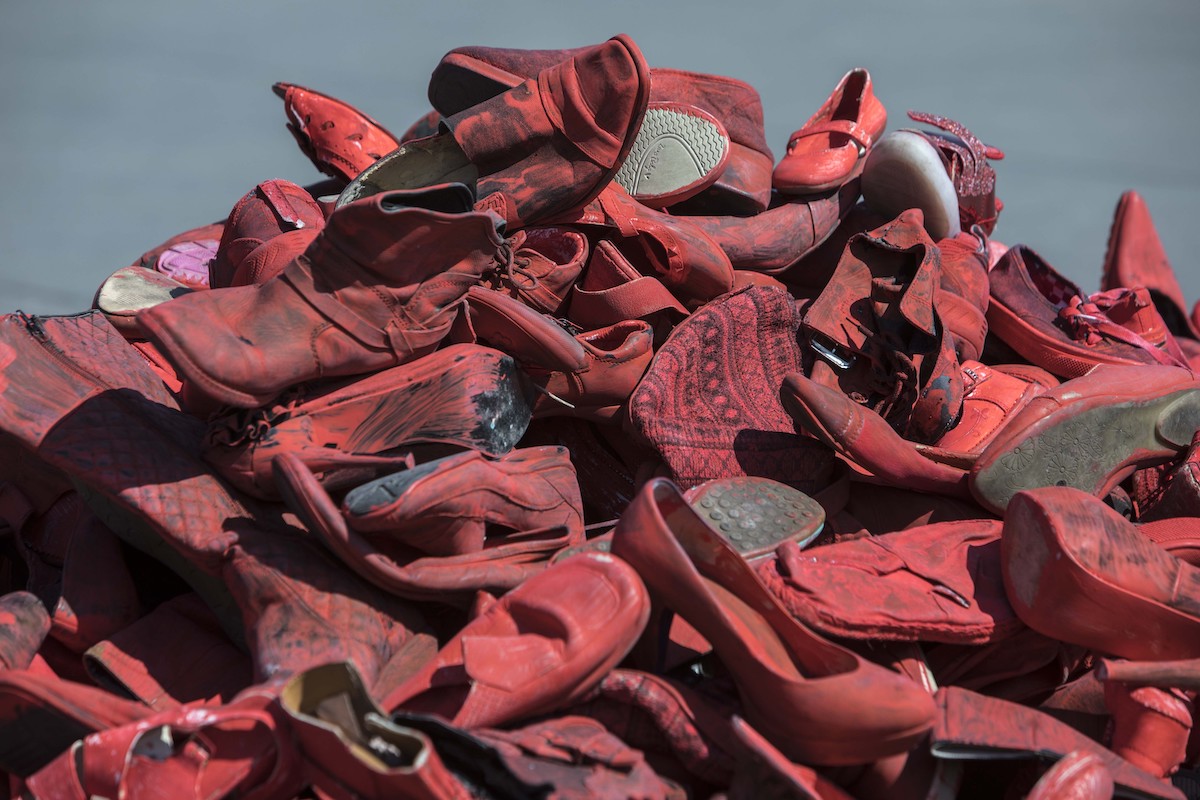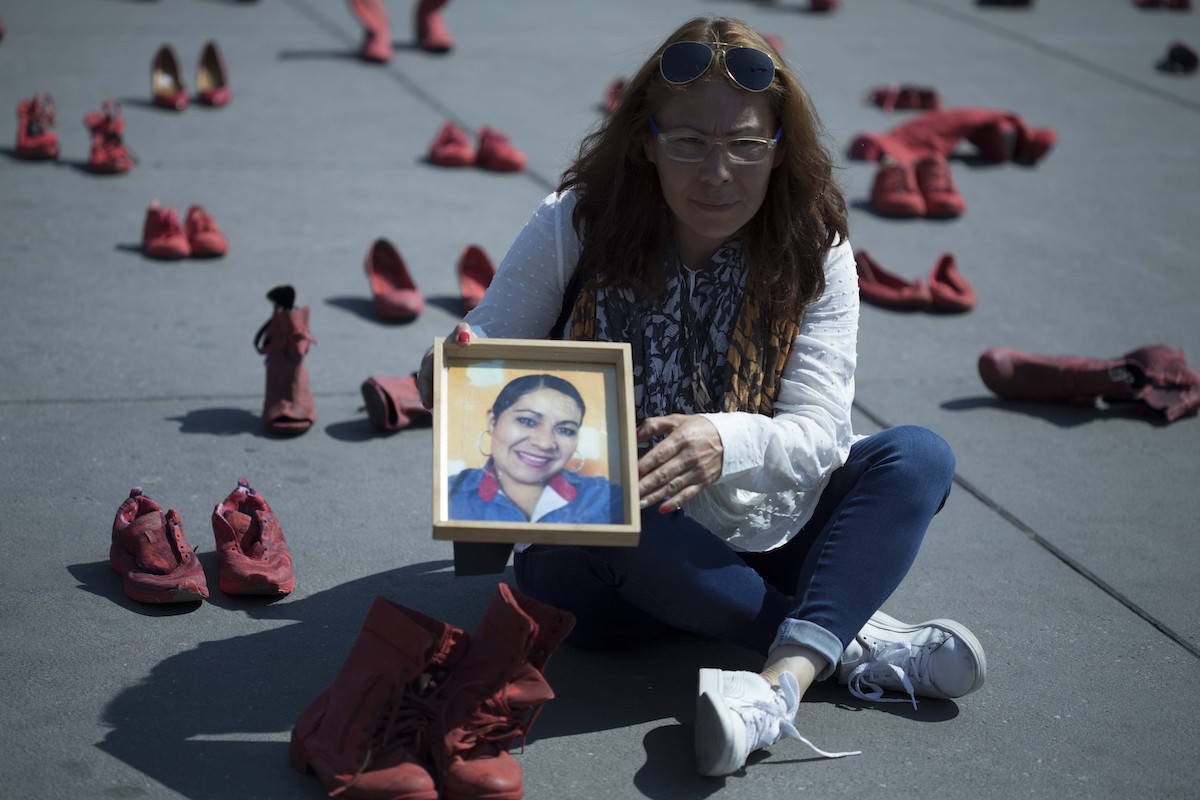

Hundreds of women’s shoes that were placed in the Plaza del Zócalo on Saturday, January 11, 2019, to protest the increase of femicides in the country. (AP Photo/Christian Palma)
By PETER ORSI, Associated Press
MEXICO CITY (AP) — Stiletto heels. Clogs. Trainers. Tiny, child-size Crocs.
Activists placed hundreds of painted-red women’s shoes on Mexico City’s sun-drenched main square Saturday to call attention to gender-based violence in a country where, on average, 10 women and girls are murdered each day and less than 10 percent of the cases are ever solved.
As residents and tourists milled about the plaza, or Zócalo —the historical, political, cultural and religious heart of the country— demonstrators marched to the massive front door of the colonial-era National Palace and placed five pairs on the paving stones as a uniformed guard looked on.
“Not one more killed!” they cried to the beat of a drum.
“The shoes represent absence, visualizing absence,” said 60-year-old artist Elina Chauvet, who first realized the piece of performance-protest art in 2009 after her sister was killed by her husband in a domestic violence case in the northern border city of Juárez. “The red is for the blood that has been spilled, but it is also a work that speaks of love.”
The performance was the latest in a string of public demonstrations in recent months over violence against women, including angry anti-rape protests in which demonstrators tossed glitter and defaced monuments; thousands of women in blindfolds chanting the feminist anthem “A Rapist in Your Path,” a viral phenomenon across the Americas and around the world; and more low-key marches and even knit-ins.
The common thread running throughout: Authorities’ inability to solve the problem of gender-based violence in one of the world’s most dangerous countries to be female.
President Andrés Manuel López Obrador, who has been office a little over 13 months, and allied officials have pledged to make femicide and other gender-related crimes a priority. In November, Mexico City Mayor Claudia Sheinbaum declared a gender violence alert for the capital, meaning that 20 of Mexico’s federal entities have now done so. Sheinbaum said the measure would raise awareness of the problem and deliver better results.
But for those at Saturday’s protest, little to nothing has been seen as far as results. There were 3,662 femicides, or gender-related killings of women, in 2018, before López Obrador took office, and the rate continued apace in 2019 though there are not yet final figures for the year.
“On the contrary. They keep on killing us,” said Elizabeth Machuca Campos, a 39-year-old artisan and women’s rights activist from Ocoyoacac in the neighboring State of Mexico, whose sister was murdered there in 2017. She said a suspect was detained and sentenced but at the last minute the charge was changed from femicide to homicide—something that activists and groups such as Amnesty International say is frequently done by Mexican governments at multiple levels to juke the stats on gender violence.
Machuca brought to the Zócalo a photo of her sister and the shoes she was wearing when her body was found.


Elizabeth Machuca Campos shows the portrait of her sister, Eugenia Machuca Campos in the middle of a hundred women’s shoes that were placed in the Plaza del Zócalo on Saturday, January 11, 2019. (AP Photo/Christian Palma)
“Those pairs of shoes are missing their owners,” she said, fighting back tears, “the women who have been torn from us.”
The capital’s new chief prosecutor, Ernestina Godoy Ramos, acknowledged Friday that she faces an “enormous” challenge in delivering public security for the city and promised justice in femicide cases.
“May it be heard loudly and from afar: There will be no impunity in the matter of femicides,” Olga Sánchez Cordero, López Obrador’s interior secretary, said the same day.
Violence against women is a problem that well predates the current government. In the 1990s and early 2000s, Ciudad Juárez was notorious for the unpunished killings and disappearances of hundreds of women and girls. Today activists often point to the State of Mexico, the country’s most populous, as a flashpoint for femicides.
Sacrisanta Mosso Rendón wore a T-shirt with the names and photograph of 17-year-old daughter, Karen, and 12-year-old son, Erik. Karen was raped and murdered are their house in Ecatepec, State of Mexico, in 2016, she said, and Erik was also home at the time and was strangled.
Mosso, who now leads the activist group Voices of Absence, said the killer was caught but sentenced to just five years. She called for tougher sentences in the few femicide cases that are actually solved—the near-total impunity for killings of women reflects a broader pattern of crimes generally going unpunished in Mexico.
“Unfortunately women are not safe anywhere,” Mosso said. “Governments come, governments go, and we remain in the same situation because there is no progress.”
But Chauvet, the artist, said that even if concrete results are scant so far, this and the other demonstrations are turning what was once a taboo subject into an issue of national public concern.
“Even though it would seem there is no immediate change, I think there is or rather that eventually there will be,” she said


